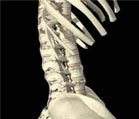|
Ankylosing
Spondylitis
(AS) is one
of many
forms of
chronic
inflammatory
arthritis,
affecting
the spine,
especially
the joints
between the
vertebrae of
the spine
and the
joints
between the
spine and
the pelvis (sacro-iliac
joints). It
may also
affect other
joints of
the body.
The joints
are
initially
inflamed and
this may be
followed by
progressive
stiffness
and
inflexibility.
It
eventually
leads to the
fusion of
the spine,
giving
permanent
painful
stiffness of
the back.
It is
often called
bamboo
spine, as
the spine
tends get
stiff like a
bamboo.
This
condition is
more common
in males as
compared to
females and
usually
occurs in
individuals
between
16-40 years
of age.
|
 |
Causes:
The exact
cause of
Ankylosing
spondylitis
is not
understood.
It has been
considered
to be an
autoimmune
disease
(like many
others such
as Diabetes,
Rheumatoid
Arthritis,
Alopecia
Areata,
Thyroiditis,
etc.).
Genetic
factors are
likely to be
involved.
The majority
of people
with
Ankylosing
spondylitis
have a gene
called
HLA-B27.
However, the
presences of
HLA-B27
(Human
|
|
|
Leukocyte
Antigen B27)
is not
absolutely
diagnostic
of Ankylosing
Spondylitis.There are
theories on
its link
with some
bacterial
infection as
a triggering
factor.
Symptoms:
These
include:
painful
stiffness of
the lower
back and
hips which
is often
worse in the
morning or
after
periods of
inactivity.
Over a
period of
time, the
pain and
stiffness
may progress
up the spine
and to other
joints such
as hips,
shoulders,
knees and
feet.
Reduced
mobility may
be noted by
the patient
and
gradually he
may notice
difficulty
in bending
the spine.
In advanced
stages of
the
condition
patient may
notice
chronic
stooping,
stiff and
inflexible
spine,
restricted
expansion of
the chest.
Features
such as loss
of appetite,
fatigue,
weight-loss,
inflammation
of the eyes
(iritis) and
of the
bowels may
also be
seen.
Homeopathic
treatment:
Homeopathic
treatment
helps two
ways:
a.
Control
underlying
disease
process
b.
Significant
Relief in
pain and
stiffness
Ankylosing
Spondylitis
(AS) being a
constitutional
disorder
calls for a
constitutional
approach to
its
treatment.
Homeopathic
approach
incorporates
detailed
study of the
cases of AS
inclusive of
the genetic
trend of the
patients.
The remedy
prescribed
after such
detailed
evaluation
offers
effective
pain control
as well as
helps in
controlling
the progress
of this
condition.
Early cases
of AS can be
treated with
good success
with
homoeopathy.
Cases that
have
advanced to
a moderate
extent can
also be
helped,
especially
in
preventing
the further
progress of
the disease
and limiting
the pain.
However,
severe cases
can only be
relieved
symptomatically
with
homoeopathic
treatment.
Homeopathy
is strongly
suggested
for
Ankylosing
Spondylitis,
especially
in the early
and mid
stages. Patients
opting for
homeopathic
treatment do
better than
those who do
not. |
Homoeopathic
Approach
It starts in two
Processes: |
- Relieves
Symptoms like:
a. Pain
b. Stiffness
c. Increases
Joint Mobility
-
Controlling and
reversing the
underlying
Disease process:
It helps by
stopping the
demineralization
and degeneration
process of the
bones of the
joint involved.
Providing
strength to the
adjoining
ligaments thus
strengthening
the whole joint,
maintaining its
space and
decreasing
pressure on the
nerves.
In mild and
moderate disease
stages complete
cure has been
achieved, in
cases were the
disease process
has lead to
destruction of
the joint as in
severe cases
homoeopathy can
offer excellent
palliative
treatment.
Patients of
Ankylosing
spondylitis are
advised to go in
for consultation
so as there
disease state
can be reviewed
and the mode of
treatment can be
decided.
|
Click
here for Case
Studies
|
|




















